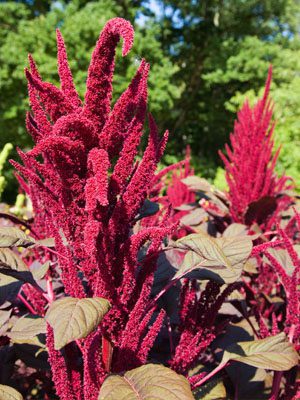Amaranth growing from seeds
Amaranth is a flowering decorative annual with a beautiful appearance and a lot of useful substances. Many wild amaranth varieties have been bred, growing from seeds and reproducing which is not at all difficult.
Growing amaranth from seeds
The height of the plant depends on the variety, it can reach from 30 cm to 2-3 meters. The color of an annual depends on the species: green, red, purple, yellow, and sometimes several shades are combined, which makes it unusually beautiful.
Amaranth: growing from the seeds of a beautiful plant with beneficial properties
The plant is used in medicine, added to food, as well as fertilizers and livestock feed
Amaranth has poor germination, so in cold areas it is planted in early February for seedlings. The soil for planting must be prepared in the fall, the soil must contain organic matter and be sufficiently loose. Seeds are planted in well-moistened soil at a depth of 0,5 cm and covered with polyethylene until the first shoots. At the end of May, seedlings can be planted in a permanent place.
If the planted seeds are illuminated and the temperature is maintained up to +20 degrees, the seedlings will develop faster.
In warm regions, conditions are more suitable for annual amaranth and growing it from seeds. When it is better to plant, the spring weather will tell, that is, the earth should warm up to 10 degrees, usually this is mid-April. Before planting in the selected area, mineral fertilizers should be applied to the soil.
If the seeds are soaked in warm water for a day before planting, they will sprout faster.
The seeds are planted in well-moistened soil up to 1,5 cm deep, the distance from each other should be more than 10 cm. After 1,5-2 weeks, young shoots will appear, with a strong thickening, they must be thinned out, and the soil should be loosened. When the plant grows up to 20-30 cm, it is necessary to fertilize with fertilizers. 3,5-4 months after planting, amaranth fully ripens and is ready for further use.
Amaranth does not need special care, it is enough to water it on time, remove weeds and periodically do top dressing. It is good to use mullein and wood ash infusions as a recharge; they must be applied to the soil 2-3 times a month. This is done in the first months after planting, until the young plant gets stronger, then frequent watering and feeding are no longer required.
Amaranth is unpretentious in care and does not require any special conditions. In order for the plant to grow well and give a crop, it is enough to adhere to simple recommendations
In addition to the beneficial properties that the annual amaranth has, it does not require much effort to grow it from seeds at home. The plant is rich in protein, dietary fiber, protein, fiber, iron, calcium. The main plus of the plant is that literally all parts of the culture, especially seeds, are suitable for food. In addition to the presence of nutrients, amaranth is also a beautiful plant and can be a wonderful decoration for a lawn or a summer cottage.










